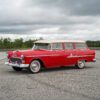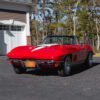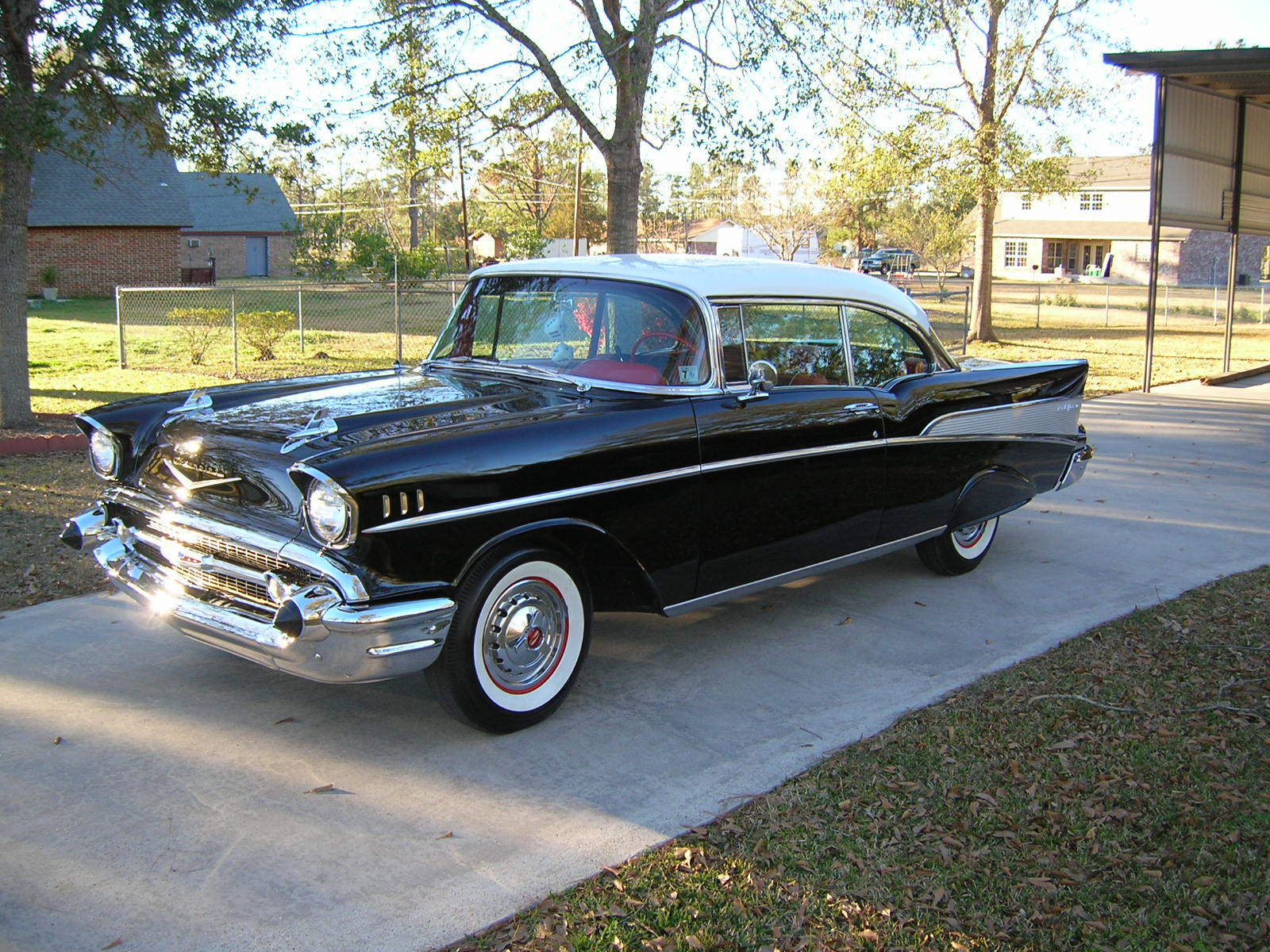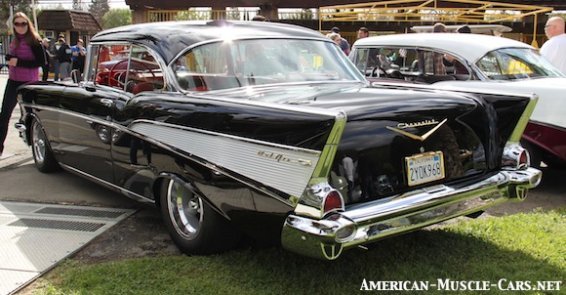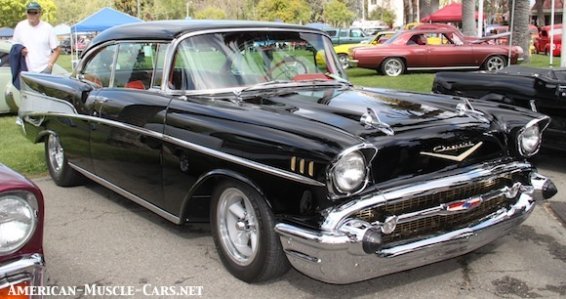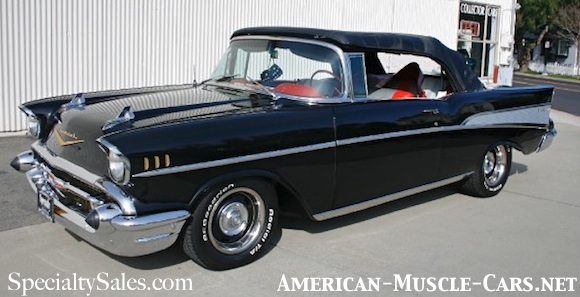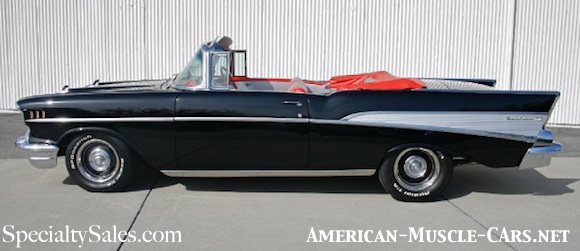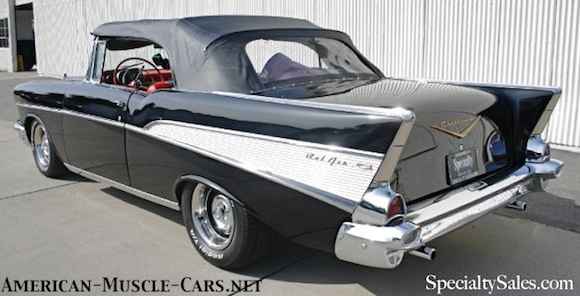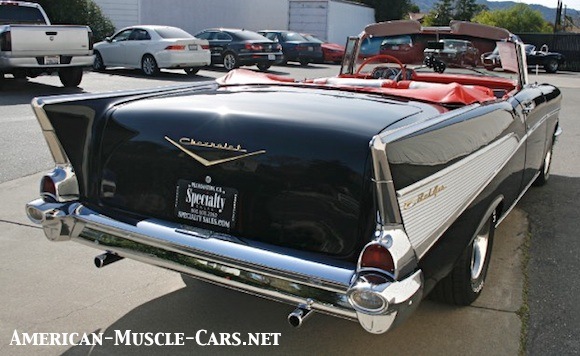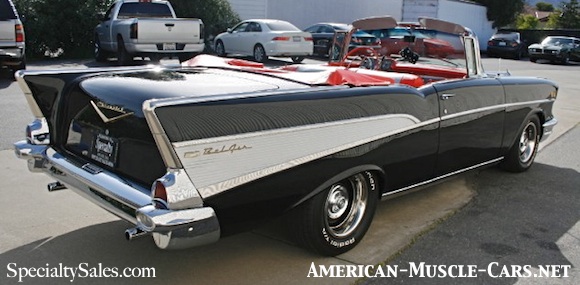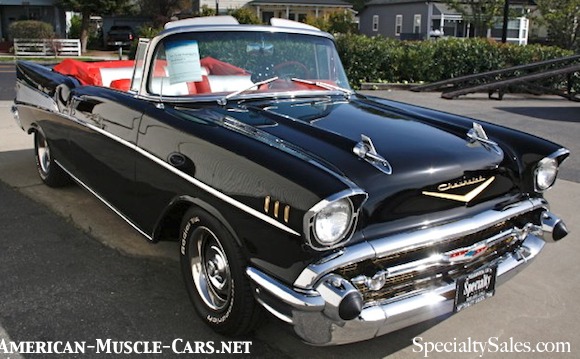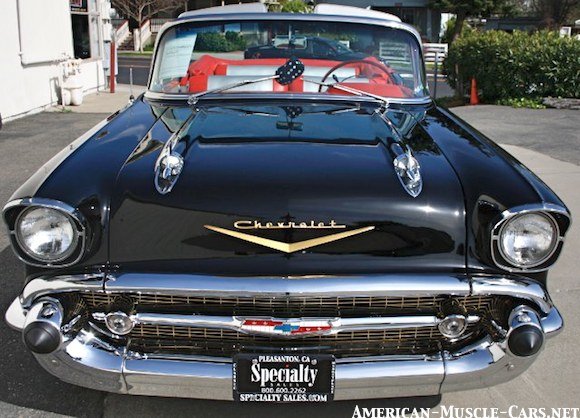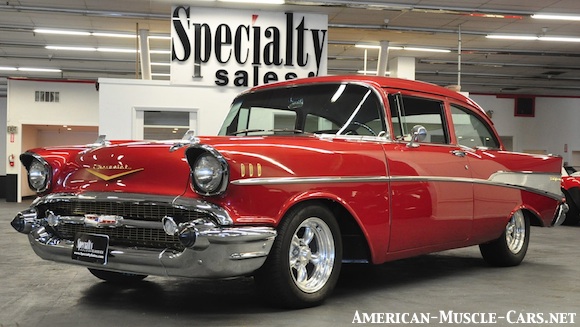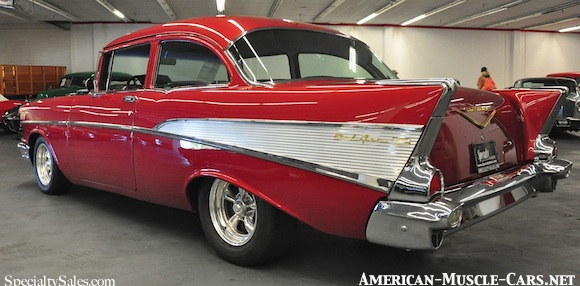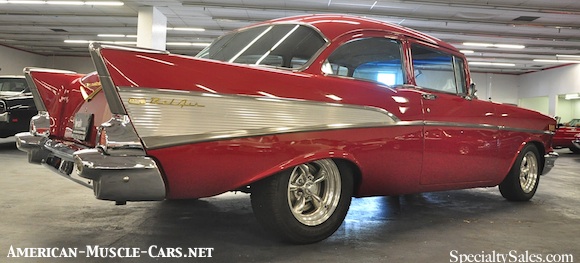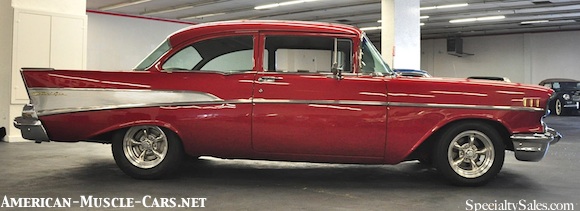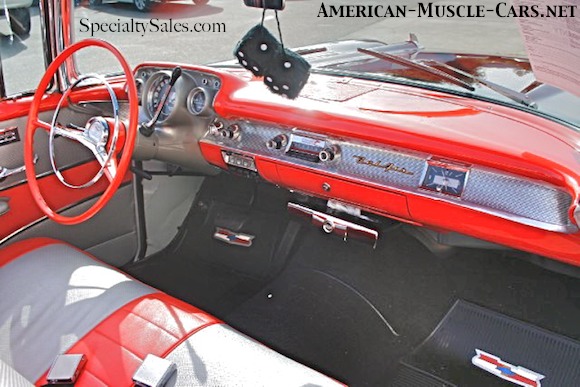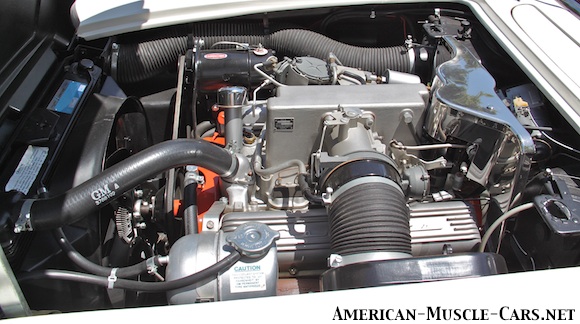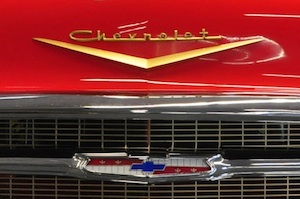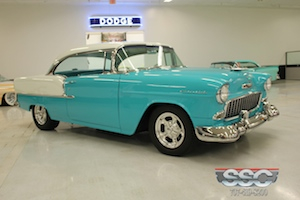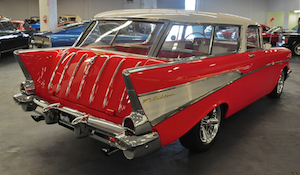1957 Chevrolet

THE NEW 1957 CHEVROLET
The ’57 Chevy was the last of the Tri-Five Chevys, the so called “Shoebox” cars, given that name because they were the first Chevrolets to have fully enclosed, streamlined fenders incorporated smoothly into the body lines, as opposed to the earlier ‘pontoon’ style fenders. A completely new car was originally envisioned for the 1957 model year, but delays in the design work delayed the new car until the following year. It was decided, instead, to do a major redesign of the 1955/56 cars already in production and selling like hotcakes. “Major” was the key word here, as it went well beyond the redux from ’55 to ’56, which reskinned the exterior but left the interior relatively unchanged. For 1957, another totally new skin was applied to the body, an entirely new dash and instrument cluster replaced the old, 14-inch wheels replaced 15s in an effort to lower the ride height, the cowl was now fully sealed, and the ventilation inlets were moved to the ‘eyebrows’ above the headlights. The 265 V8 was also punched out to 283 cubic inches, gained horsepower and even sprouted one of the first examples of mass-produced fuel injection.
1957 Chevrolet 2-DOOR HARDTOP
1957 Chevrolet CONVERTIBLE
1957 CHEVROLET STYLING
Chevy really nailed the look of the ’57 Chevy, and in doing so, really defined the “classic 50’s big fin-look”. Sure the ’59 Cadillac’s were bigger, the Mopar’s were wilder, but the 1957 Chevy tailfin was just about the perfect size and shape, especially in Bel Air trim. It had just enough chrome, but not quite too much, like the cars that would come immediately after. Styling really went off the charts by 1959, peaking around that time with some of the most garish cars of all time, like the ’59 Caddie, the Edsel, and the ’59 Impala. It was crazy, and by this time people began to sense that, and styles cleaned up very quickly starting in the 1960 model year. 1957 marked perhaps the high water mark of 1950s styling, because it was already well on its way to excess, but also not as plain as the ’55 models had been. Great detail, all drenched in chrome and anodized gold, was lavished on the car. The ‘missile launchers’ in the hood, the hooded ‘eyebrows’ over the headlights, that big wide-mouthed grill adorned with more glitz and glamour than a Hollywood red carpet, the twin “Dagmars” (the black-tipped breast-shaped appendages on either side of the front grille, named after a movie starlet who was known for her own breast-shaped appendages), and of course those incredible tail fins, all contributed to a bold new look.
1957 Chevrolet 2-DOOR COUPE
1957 CHEVROLET SALES ARE SLOW
Despite all the added eye-candy and horsepower, sales continued to slip off of their high in 1955. But worse than selling fewer cars than the year before, for the first time since 1935 Ford outsold Chevrolet. If you look at the 1957 Fords, while nice, its hard to imagine more people choosing one of a ’57 Chevy at the time. But there was another factor to consider that played heavily into the sales race. The 1957 Chevrolet was the first car to come equipped standard with tubeless tires. Tubeless tires were brand-new and in the minds of the public, largely unproven. Ford was still using inner tubes in their tires, and people trusted them because that was all they knew. The idea of a tire without a tube in it just didn’t make sense to a lot of people. What will hold the air in, right? There was just enough skepticism in the market to give Ford the edge they needed. It’s not that ’57 Chevy sales were low, they still sold over 1.5 million cars! And considering that was just one basic car, albeit in a variety of trim levels and body styles, that’s quite an accomplishment. A great many modern-day auto makers would be green with envy over a production number that high. Over time, the ’57 Chevy has endured as one of the all-time favorite classic cars, an icon that has been hot rodded, raced, customized and lovingly restored for decades. Today they are more popular then ever.
1957 Chevrolet 4-DOOR HARDTOP

ABOVE: 1957 CHEVROLET BEL AIR 4-DOOR HARDTOP
There was a difference between the 4-door Hardtop and the 4-door Sedan. The Sedan was posted (has a full B-pillar) and had framed windows. The Hardtops eliminated the B-pillar (also called the “Post”) and window frames, creating one huge open space when all the side glass was down. The slope of the C-pillar was also more “swoopy” on the Hardtop, where the standard Sedan had a much boxier rear section.
1957 Chevrolet 4-DOOR STATION WAGON

ABOVE: 1957 CHEVROLET 210 4-DOOR STATION WAGON
1957 Chevrolet BEL AIR NOMAD

ABOVE: 1957 CHEVROLET BEL AIR NOMAD “SPORT WAGON”
Notice the differences between this Nomad and the 4-door Station Wagon above it: 1.) Of course, the Nomad has 2 doors & the Wagon has 4. 2.) The Nomad’s doors had frameless windows, like the Hardtop & Convertible, whereas the Wagon had conventional framed windows. 3.) The Nomad’s rear-side windows slid forward & back to open, where the Wagon had conventional roll-down windows. 4.) The Nomad’s tailgate is set at a very rakish angle, where the Wagon’s gate is much more vertical. 5.) While you can’t see it here, the Nomad’s tailgate has 7 chromed vertical spears, and the Wagon does not. 6.) Also not very visible here, all ’55 to ’57 Nomads had body lines (grooves) running from side-to-side across the roof, from the B-pillars back, where the Wagon’s roof was smooth. There are many more differences, but these are the main ones. Nomads were meant to be “Sporty Wagons” or “Sport Wagons”. They weren’t as practical as a conventional Wagon perhaps, but they were still immensely practical. I owned a ’55 Nomad for many years and still hold it as my favorite all-time personal car.
1957 Chevrolet INTERIORS
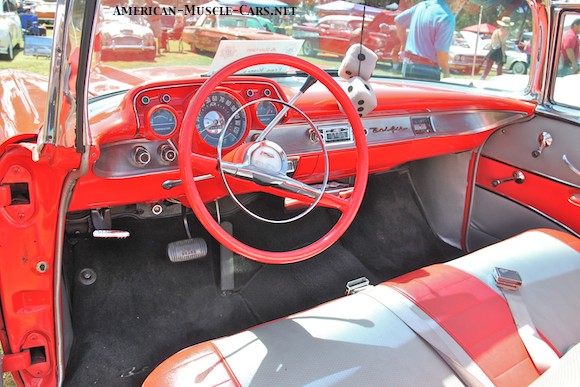
1957 CHEVROLET INTERIORS & OPTIONS
Each trim level, 150, 210 and Bel Air had its own interior design, commensurate with its price point. The Del Ray was actually a 210 with the Bel Air interior. As always back in those days, Chevy did a stellar job with the interior styling. The ’57 was completely redone with a whole new dash and instrument cluster, now made up of spherical pods containing the gauges. There was an ever-growing list of optional equipment as well: Air conditioning, power steering and brakes, power windows, power seats, auto-dimming headlights, and a signal-seeking AM radio with power antenna and rear speaker with separate volume control (dubbed “Surround Sound”). The radio, which used vacuum tubes, had been completely redesigned to run on far less power, allowing it to be played longer with the engine shut off. It was very common in those days to run your battery so that the car wouldn’t start, by listening to the radio. There were also a expanding list of safety items being offered, like seat belts, shoulder harnesses, a padded dash, all optional, and ‘crash-proof door locks’ as standard equipment.
1957 Chevrolet ENGINES
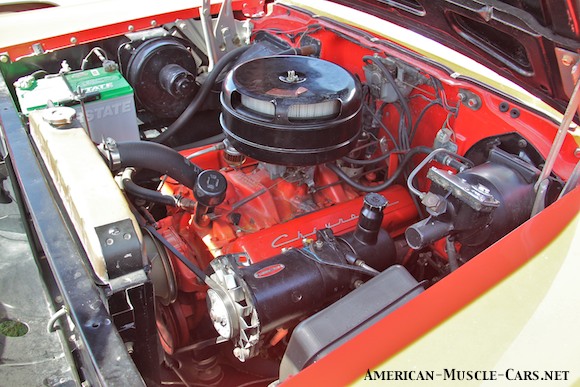
1957 CHEVROLET ENGINES
The big news for ’57 was really in the engine compartment. The 265 small block V8 was bored out to 283 cubic inches and the horsepower increased commensurately. Corvette engines were now available, and the top performance offering was the 283-horsepower 283 with Rochester mechanical fuel injection. This was the first passenger car ever to achieve the benchmark of one horsepower per cubic inch. Of course we’re now approaching 200hp per liter, which is somewhere north of 3 horsepower per cubic inch! Ah, technology!! But, back in ’57, it was back to basics. The standard engine was the 235 “Blue Flame” six producing 140hp. The 265 V8 continued in ’57 alongside the new 283. The base 265 “Turbo-Fire” V8 made 162hp. Next up were the 2-barrel 283 “Turbo-Fire” making 185hp, and the 4-barrel 283 “Super Turbo-Fire” with 220hp. A more radical race engine that would prove barely streetable was the 270hp 283 with two 4-barrel carburetors, a Duntov cam and solid lifters. But the top-of-the-performance-heap was the 283hp fuel injected 283, which also had the Duntov cam and solid lifters. This was the first production engine ever to produce one horsepower per cubic inch, quite an achievement at the time. But alas, it was an expensive option, and beyond the scope of most mechanics to keep it in proper tune, so it was never produced in large numbers. It was a brilliant achievement for GM at the time and these Rochester “Fuelies”, especially the larger ’63 to ’65 versions are very sought after today by collectors. Back in the mid-70s I was tearing around California’s Central Valley in a ’55 Nomad with a 375hp 327 with the big Rochester fuel injection system. I was able to keep it in tune, and it was fast, very fast. The secret was that it allowed me to shift about 500rpm later than the carburated cars, the best 500rpm, at the top of the power band. What an engine!!
ROCHESTER MECHANICAL FUEL INJECTION
If this wasn’t the first mass-produced fuel injection system, it had to be one of the first. It also allowed Chevy to achieve another stunning first: One horsepower per cubic inch with the 283hp 283 V8, introduced in 1957 in the Corvette and Bel Air. It actually made more like 300hp, but Chevy thought there was more marketing value in matching the two numbers.
1957 CHEVROLET TRANSMISSIONS
The standard transmission for all models across the board was the 3-speed manual, with synchromesh in 2nd and 3rd gears only. This could be optioned up to a 3-speed with overdrive, a 4-speed manual (a dealer-installed option) or an automatic. Until now, and since 1950, the only automatic transmission offered on a Chevy was the 2-speed Powerglide, a relatively uncomplicated tranny that did everything that it was called upon to do, and had established a solid reputation for reliability. However in 1957 GM, always a leader in the field of automatics, introduced the first of a series of “Turbo” automatic transmissions. This first one was called the Turboglide, and was an offshoot of Buick’s Dynaflow. At the time, its main casing was the largest cast aluminum item ever mass produced. However, it was heavy and complicated, and quickly got the reputation for being problematic. So, the vast majority of automatic buyers opted for the Powerglide.
1957 Chevrolet PRODUCTION NUMBERS
| MODEL
150- 2 door Sedan 150- 2 door Utility Sedan 150- 4 door Sedan 150- 2 door Station Wagon (Handyman) 150- 2 door Sedan Delivery 210- 2 door Sedan 210- 2 door Club Coupe (Del Ray) 210- 4 door Sedan 210- 2 door Hardtop Sport Coupe 210- 4 door Hardtop Sport Sedan 210- 4 door Townsman Station Wagon 210- 2 door Wagon (Handyman) 210- 4 door Beauville Station Wagon Bel Air- 2 door Sedan Bel Air- 4-door Sedan Bel Air- 2 door Hardtop Sport Coupe Bel Air- 4 door Hardtop Sport Sedan Bel Air- Convertible Coupe Bel Air- 2 door Nomad Wagon Bel Air- 4 door Townsman Station Wagon Corvette Convertible |
BODY STYLE
1211 1211B 1219 1263F 1271 1011 1011A 1019 1037 1039 1062F 1063F 1011D 1019D 1037D 1039D 1067D 2934 |
U.S. PRODUCTION
70,774 8,300 52,266 14,740 7,273 162,090 25,644 260,401 22,631 16,178 127,803 17,528 21,803 62,571 254,331 166,426 137,672 47,562 6,103 27,375 |
Other TRI-FIVE CHEVYS
The 1955, 1956 & 1957 Chevrolets were major watershed cars in their era. Numerous body styles & 3 trim levels.
The 1955 was the car that changed it all. Major technical innovations & flashy new styling + that hot little small block V8 made it a hit.
Mechanically, they were mostly carried over from the red-hot ’55, with some improvements. But the exterior was totally redone for a whole new look. The first step toward Wider-Lower-Longer styling.
Chevy’s ‘Sport Wagon’ started out as part of the original Corvette concept car, but when the Vette was produced as a Roadster, the Nomad became a limited-production, high-priced 2-door wagon loaded with unique features.


